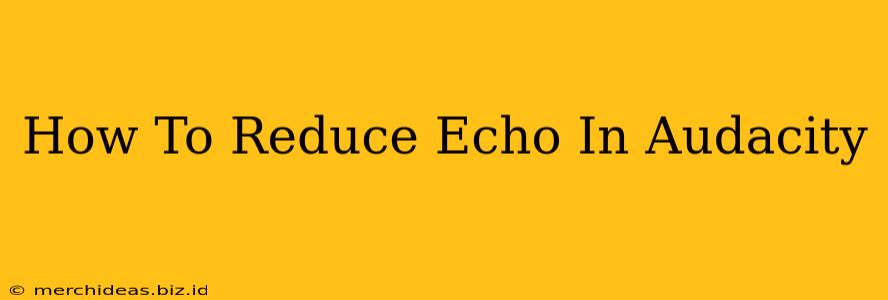Echoes in audio recordings can be incredibly frustrating, ruining otherwise perfect takes. Fortunately, Audacity, a free and powerful audio editor, offers several effective ways to reduce or even eliminate unwanted echo. This guide will walk you through various techniques, from simple noise reduction to more advanced methods, ensuring you achieve the best possible sound quality.
Understanding Echo and its Causes
Before diving into the solutions, it's helpful to understand what causes echo in the first place. Echoes are created when sound waves bounce off surfaces like walls, ceilings, or even hard floors. This creates a delayed repetition of the original sound, often resulting in a muddied, less clear recording. The severity of the echo depends on factors such as the room's acoustics, the distance between the sound source and reflective surfaces, and the recording equipment used.
Methods to Reduce Echo in Audacity
Audacity provides several tools to combat echo. The best approach depends on the severity of the echo and the characteristics of your audio. Let's explore some effective strategies:
1. Noise Reduction Effect
Audacity's built-in Noise Reduction effect is a great starting point. While not specifically designed for echo removal, it can effectively lessen the overall background noise, which often includes the subtle reverberations contributing to the perceived echo.
- Get a Noise Profile: Select a portion of your audio that contains only background noise (no vocals or instruments). Go to Effect > Noise Reduction. Click "Get Noise Profile."
- Apply Noise Reduction: Select your entire audio track and go back to Effect > Noise Reduction. Adjust the "Noise Reduction" slider to fine-tune the effect. Start with small adjustments and preview the results to avoid over-processing. Too much reduction can make your audio sound unnatural.
Important Note: This method works best for consistent background noise. For distinct echoes, it may not be sufficient on its own.
2. The "Echo Removal" Plugin (Optional)
While Audacity doesn't have a built-in echo removal tool, several plugins are available that can provide more targeted echo reduction. These often use advanced algorithms to identify and suppress echoed sounds more precisely than the Noise Reduction effect. Searching online for "Audacity echo removal plugin" will provide various options. Remember to always download plugins from trusted sources to avoid malware. Installing and using a plugin typically involves placing the plugin files in the correct Audacity directory and then selecting it from the Effect menu.
3. Using the Equalizer Effect
A subtle adjustment of your audio's frequencies using the equalizer can help reduce the perception of echo. Echoes often have a slightly different frequency balance compared to the original sound. Experiment with gently cutting some frequencies in the lower mid-range, which is where echo often resonates. Remember to listen carefully and avoid over-processing!
4. Careful Mic Placement and Recording Environment
The most effective way to deal with echo is to prevent it in the first place. Next time you record, consider the following:
- Use a good quality microphone: A high-quality microphone often has better noise rejection capabilities.
- Minimize reflective surfaces: Record in a room with sound-absorbing materials (curtains, rugs, soft furnishings) to reduce sound reflections.
- Position your microphone strategically: The closer the microphone is to the sound source, the less likely an echo will be picked up.
5. Advanced Techniques (for experienced users)
For more complex cases or for those with experience using audio editing software, advanced techniques might include using spectral editing tools to manually identify and remove echo frequencies or employing multi-band compression to level out dynamic ranges, reducing the impact of delayed sound reflections.
Conclusion: Achieve Crystal-Clear Audio
Reducing echo in Audacity is achievable with careful application of the right techniques. Start with the simpler methods like noise reduction and equalizer adjustments. If these aren't sufficient, explore plugins for more powerful echo removal capabilities. Remember, prevention is always better than cure, so invest time in optimizing your recording environment and microphone placement to minimize echoes before they even reach your recording. By combining these approaches, you can significantly enhance your audio quality, resulting in a polished and professional-sounding final product.
